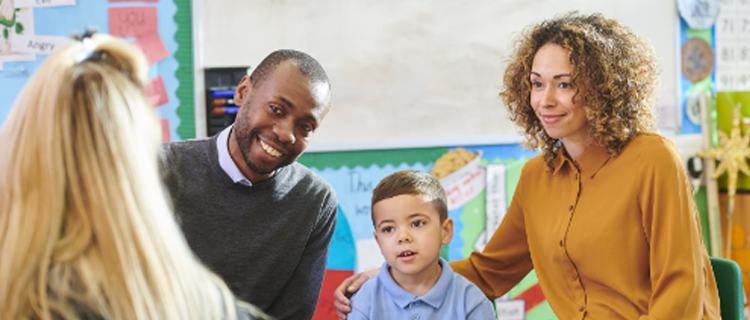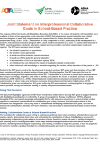How To: Writing Collaborative Goals for IEPs
When it comes to helping students meet their goals, collaboration is key. By working together, educators and specialized instructional support personnel (SISP)—including speech-language pathologists (SLPs), occupational therapists, physical therapists, and classroom teachers—can better understand and support their students. This is especially true in the development of a student’s Individualized Education Program (IEP).
Why Writing Collaborative IEP Goals Is Important
When developing a student’s IEP, the education team writes student-centered goals and defines how each team member will help the student achieve those goals. The entire team should be involved in creating those goals. Although this may take more time upfront, it ultimately makes the team’s work more efficient.
Collaborating on IEP goals ensures the following outcomes:
-
All team members understand not only their own role supporting the student, but the roles of their colleagues. This enables the entire IEP team to collaborate better and help students beyond just what they see in their classroom.
-
The educators can adapt their services to build on each other’s work. For example, in this case study, the team worked together on a plan using speech-language therapy telepractice services and a speech-generating device (SGD).
-
The team can streamline and simplify data collection. Rather than each team member collecting their own data about student progress, the team can work together using one shared, simplified system.
For examples of collaborative IEP goals, see these case studies. To learn more about collaborative goals, read this joint statement [PDF] from the American Occupational Therapy Association, the Academy of Pediatric Physical Therapy, and ASHA.
Joint Statement from the American Occupational Therapy Association, the Academy of Pediatric Physical Therapy, and ASHA
How to Write Collaborative Goals with Your IEP Team
ASHA developed this rubric [PDF] to guide your team through the collaborative goal-writing process and follow-up meetings. Download it, and bring it to your initial IEP meeting.
In your initial IEP collaborative goals meeting, the team should take the following actions:
1. Identify educational impact.
This section describes how a student’s differences may impact their educational performance. By considering the student’s strengths and needs, the IEP team can write strong goals.
2. Record the student’s present levels from the perspective of each team member.
Each member of the IEP team should add information based on their own evaluation of the student. For example, the SLP may add information about the student’s language ability.
3. Collaborate on goal development.
The team works together to write goals that incorporate each team member’s feedback.
4. Determine how each team will support the student in achieving that goal.
Define what each member of the IEP team will do, and identify their objective.
5. Develop a system for collecting data about student progress.
Team collaboration doesn’t end with writing goals. The members also need to collaborate on collecting data to track a student’s progress. This will help them make informed decisions about interventions, service provision, and goal achievement.
6. Make a plan for following up with team members.
Plan regular check-ins with team members to review the student’s progress, and adjust your work accordingly.
Bringing Collaborative Goal Writing to Your School
Establishing a process for collaborative goal writing takes time. Schools interested in rethinking their IEP goal-writing process should start by communicating that intention with educational teams and parents, identifying times and strategies for planning, and creating a timeline to begin the process.
In addition to planning, writing collaborative goals also requires a committed educational team. Team members must be able to articulate what they do, demonstrate their value to the student, and understand how other team members contribute. To help your team develop needed skills, consider creating an interprofessional education (IPE) exercise. See the how-to section for ideas on how to plan and develop an IPE curriculum.
Need help advocating for collective IEP goal writing at your school? See this resource for talking points.
Sample Collaborative Goal
Below is an example of a collaborative goal. For more examples, see these case studies.
| Goal Area | Summary |
|
Educational Impact (Team reports history, strengths, and area(s) for development) |
Student is having difficulty independently completing more than 10% of a one-page written assignment (e.g., 1 of 10 short answers or fill-in-the-blank answers). |
|
Present Levels (Based on Evaluation Data) (Assessment results) |
Can’t sit up in chair for more than 5 minutes without leaning on the desk due to low muscle tone and fatigue. Decreased ability to write due to poor fine-motor skills, inattention, literacy level, and working memory. Difficulty following instructions and asking for help due to expressive and receptive language, short-term memory, and sequencing problems. Busy classroom environment with music playing, students talking, and movement around the room. |
|
Collaborative Goal |
Student will demonstrate improved participation in classroom activities with his peers by independently completing 50% of a written assignment in the same amount of time used by his classmates, at least three out of four opportunities per week, for 4 consecutive weeks as measured by teacher/service provider report, classroom observations, and work samples. |
|
How Is the Goal/Objective Being Addressed? |
PT: Provide adaptive seating, work with classroom teacher on incorporating core-strengthening activities into daily movement breaks, collaborate with physical education teacher on core-strengthening exercises. OT: Provide assistive technology support for using voice-to-text and other technology to promote work completion and demonstration of knowledge; work with student and teachers to integrate self-regulation strategies throughout the school day; provide visual supports for sequencing assignments and organizing materials; establish quiet spaces for working. SLP: Provide expressive and receptive language activities linked to the classroom curriculum and themes; coach the student in the use of compensatory strategies (e.g., encourage the use of lists for sequencing and short-term memory; create visual supports for assignment instructions). General Education Teacher: Develop grade-level-appropriate activities; provide modification stipulating that the student must only complete 50% of each writing assignment; use visual supports throughout instructional day; incorporate movement, self-regulation, and strengthening activities. Special Education Teacher: Implement specially designed instruction related to literacy development; collaborate with general education teacher to set expectations for modified assignments; integrate self-regulation and strengthening activities; instruct student in the use of assistive technology; facilitate communication across team members. |
 When it comes to helping students meet their goals, collaboration is key. By working together, educators and specialized instructional support personnel (SISP)—including speech-language pathologists (SLPs), occupational therapists, physical therapists, and classroom teachers—can better understand and support their students. This is especially true in the development of a student’s Individualized Education Program (IEP).
When it comes to helping students meet their goals, collaboration is key. By working together, educators and specialized instructional support personnel (SISP)—including speech-language pathologists (SLPs), occupational therapists, physical therapists, and classroom teachers—can better understand and support their students. This is especially true in the development of a student’s Individualized Education Program (IEP).









